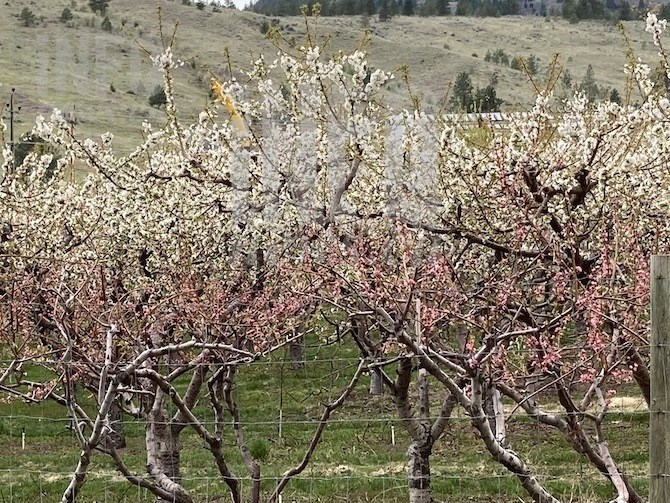Fruit growers face tough decisions on foreign labour after losses

The Okanagan fruit industry is heavily dependent on thousands of temporary foreign workers in order to get the crop growing properly and harvested.
But many farmers are being forced to make tough decisions on whether to spend the money to bring in workers in the face of dramatically diminished crops because of last month’s deadly cold snap.
Five extremely cold days in January wiped out the grape crop and may have destroyed up to 80% of the Valley’s peach crop.
READ MORE: Up to 80% of Okanagan peach crop wiped out by winter cold snap
Cherry growers can’t yet put the damage to their crops in percentage terms but know it is substantial.
“We won’t know until the trees wake up and the sap starts flowing but there are definitely areas where the vast majority of people’s flower buds have been damaged by the cold, upwards to probably 100% of the flowers in really cold areas,” Sukhpaul Bal, president of the B.C. Cherry Association, told iNFOnews.ca. “Creston has been reporting some pretty heavy damage. I imagine Kelowna and north could be hit as well some areas in Summerland.”
Cherry trees are hardier than grape vines so he doesn’t expect the actual trees to have been killed, but some branches will likely have to be pruned back and some newer plantings may not have fared all that well.
While determining the full extent of the damage and how to respond to it is top of mind for cherry growers, they are caught in a time crunch in order to decide how many workers to recruit.
Bal didn’t have a number on how many temporary foreign workers, mostly from Mexico, are brought into the Valley each year but, in 2020, the Okanagan fruit industry recruited 4,500 such workers and the cherry growers are one of the biggest employers of temporary foreign workers.
READ MORE: Okanagan orchards and farms still short on labour after foreign workers allowed
While some workers will still come to help with the pruning – which has to be done despite the damage from the cold – the greatest need will be for pickers starting in June.
“The tricky thing is, you almost have to have those visas being processed already,” Bal said. “It gets to be quite a tough decision process of how many workers you bring and how many flights do you book? If you wait too long to book the flights, the prices are astronomical. They already are very high. I’m hearing it's upwards of $1,000 per worker just to get them here, with all the fees.”
Only one airline can be used for the temporary foreign worker program from Mexico so growers don’t have control over those costs. A separate program does allow more flexibility and the use of often cheaper commercial flights.
Regardless of whether growers are going to get those numbers right, there will be fewer foreign workers and that will have a ripple effect through the economy.
“A lot of the money goes back to families in their home countries but a good chunk of it goes to groceries,” Bal said. “They’re working hard and eating lots of food. That’s going to be a substantial chunk of spending that doesn't happen in our Valley.”
In recent years the cherry industry has thrived and expanded but, along with other segments, is now looking to the government for help, especially after record heat hit in 2021 followed by killing cold in the last two winters.
“We’re meeting with the government and pointing out the insurance programs are not really designed for cumulative events year in and year out,” Bal said. “It was to buffer that one bad year, maybe two, then the grower bounces back with an average or above average crop and makes some revenue. We’re in a situation where they’re having to rely on their insurance payments and that does start decreasing when you continue to rely on it.”
READ MORE: Importing grapes may save the Okanagan wine industry
But that’s only one of the many challenges the farming industry is facing.
“We’re looking for some immediate solutions so we can go back to our way of being a highly productive industry that is an economic driver in the Valley,” Bal said. “Cherry growers are not in this business to be reliant on these programs. We have a good marketing strategy and a good demand for our product. I use the analogy that that’s our office outside. If your office is being decimated year in and year out, how do you get any work done?”
Bal hopes the public understands how essential it is that farmers survive and that they support government assistance. The alternative could be the Valley reverting back to the erosion of farmland that it has seen in the past.
“People who were around in the Valley years ago will remember a lot of our farmland was just going into estates,” Bal said. “It wasn’t being used for its best use. Then, more recently, the purchases of properties within the Valley have been farmers buying it to plant. I think everybody would get behind that’s what should be happening. This is more of a food security issue and the bigger topic is that we need farmers working the land.”
To contact a reporter for this story, email Rob Munro or call 250-808-0143 or email the editor. You can also submit photos, videos or news tips to the newsroom and be entered to win a monthly prize draw.
We welcome your comments and opinions on our stories but play nice. We won't censor or delete comments unless they contain off-topic statements or links, unnecessary vulgarity, false facts, spam or obviously fake profiles. If you have any concerns about what you see in comments, email the editor in the link above. SUBSCRIBE to our awesome newsletter here.


